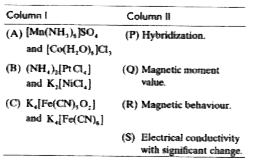Different properties are seen in which pair
B(OH)3,Al(OH)3
Be(OH)2,Al(OH)3
NaOH,Ca(OH)2
None of these
To solve the question of which pair shows different properties, we will analyze the hydroxides mentioned in the options and determine their nature (acidic, basic, or amphoteric).
1. Identify the Hydroxides:
- The question involves comparing different hydroxides. We will consider:
- Boron hydroxide (B(OH)₃)
- Aluminum hydroxide (Al(OH)₃)
- Beryllium hydroxide (Be(OH)₂)
- Sodium hydroxide (NaOH)
- Calcium hydroxide (Ca(OH)₂)
2. Analyze Boron Hydroxide (B(OH)₃):
- Boron hydroxide is known as boric acid (H₃BO₃).
- It is acidic in nature.
3. Analyze Aluminum Hydroxide (Al(OH)₃):
- Aluminum hydroxide is amphoteric in nature.
- This means it can react with both acids and bases.
4. Analyze Beryllium Hydroxide (Be(OH)₂):
- Beryllium hydroxide is also amphoteric in nature.
- Similar to aluminum hydroxide, it can react with both acids and bases.
5. Analyze Sodium Hydroxide (NaOH):
- Sodium hydroxide is a strong base and is classified as basic.
6. Analyze Calcium Hydroxide (Ca(OH)₂):
- Calcium hydroxide is also a strong base and is classified as basic.
7. Comparison of Properties:
- From the analysis:
- Boron hydroxide (acidic) vs. Aluminum hydroxide (amphoteric) shows different properties.
- Beryllium hydroxide (amphoteric) vs. Aluminum hydroxide (amphoteric) shows the same properties.
- Sodium hydroxide (basic) vs. Calcium hydroxide (basic) shows the same properties.
8. Conclusion:
- The pair that shows different properties is Boron hydroxide (B(OH)₃) and Aluminum hydroxide (Al(OH)₃).
- Therefore, the correct answer is Option 1.
- The question involves comparing different hydroxides. We will consider:
- Boron hydroxide (B(OH)₃)
- Aluminum hydroxide (Al(OH)₃)
- Beryllium hydroxide (Be(OH)₂)
- Sodium hydroxide (NaOH)
- Calcium hydroxide (Ca(OH)₂)
- Boron hydroxide is known as boric acid (H₃BO₃).
- It is acidic in nature.
- Aluminum hydroxide is amphoteric in nature.
- This means it can react with both acids and bases.
- Beryllium hydroxide is also amphoteric in nature.
- Similar to aluminum hydroxide, it can react with both acids and bases.
- Sodium hydroxide is a strong base and is classified as basic.
- Calcium hydroxide is also a strong base and is classified as basic.
- From the analysis:
- Boron hydroxide (acidic) vs. Aluminum hydroxide (amphoteric) shows different properties.
- Beryllium hydroxide (amphoteric) vs. Aluminum hydroxide (amphoteric) shows the same properties.
- Sodium hydroxide (basic) vs. Calcium hydroxide (basic) shows the same properties.
- The pair that shows different properties is Boron hydroxide (B(OH)₃) and Aluminum hydroxide (Al(OH)₃).
- Therefore, the correct answer is Option 1.
Similar Questions
Knowledge Check
Deuterium is different from hydrogen in which property
AReacts more than hydrogenBReacts less than hydrogenCIt emits beta particlesDIts reactivity is same as that of hydrogenDifferent objects at different distances are seen by the eye. The parameter that remains constant is
Athe focal length of the eye lensBthe object distance from the eye lensCthe radii of curvature of the eye lensDthe image distance from the eye lensWhich of the following properties are different for Ianthan ides and actinides?
ATheir radioactive natureBTheir tendency to form oxo-ionsCTheir tendency to form complexesDAll of them
List two important properties in which boron differs from the rest of the members of group. Mention the main reasons for the difference.
View SolutionMatch the pair of complex compounds with the properties that are different in them.
 .
.
View SolutionDifferent object at different distances are seen by the eye . The parameter that remains . Constant is
View SolutionIsotopes have ______.
I. similar physical quantities and different chemical properties
II. different physical properties
III. similar chemical properties
View SolutionThe isotopes of hydrogen have different physical properties due to difference in mass. They have almost same chemical properties with a difference in their rates of reactions which is mainly due to
View Solution
